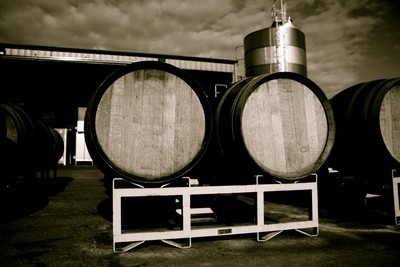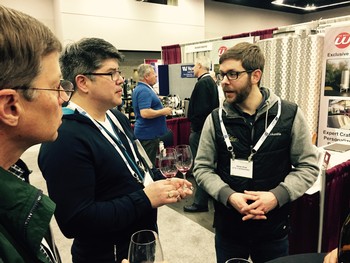Oregon Wine Symposium Part One - A to Z & REX HILL Wine Trial Presentation
While attending the Oregon Wine Symposium in Portland last week, A to Z, REX HILL and a few other wineries were able to present some of their research and development projects. I had the opportunity to present a project I supervised last harvest at REX HILL.
There are two distinct phases to make wine from Pinot Noir once the grapes have been harvested and put in a vessel:
- The Cold Soak Phase which is when the berries or clusters are left soaking in their juice at cold temperature. This is when we will typically extract the anthocyanins, which are pigments responsible for the color of the wine.
- The Alcoholic Fermentation Phase happens at a warmer temperature, and is when you extract most of the tannins responsible for the structure of the wine.
We designed our trial to be able to quantify how much of the anthocyanins and tannins would be extracted during the cold soak period. After leaving the must for two weeks at 40F we ran our first batch of analyses. We then pulled a barrel worth of juice and fermented it in order to see if the alcoholic fermentation would, in any way, affect these numbers. We were hoping to create a wine that has a dark color but a lighter body. The must left in the tank was fermented traditionally with native yeast and got a couple of daily pump overs or punch downs and would serve as a reference point.
We got some good results from this trial and we thought it would be great to publically share what we have learned. So here I am, presenting the trial, answering questions and explaining why we did what we did to a public who was very appreciative of the conversation. They had the opportunity to taste both wines: the wine made from juice fermented in the barrel and the wine made traditionally. The wine fermented in barrel has a good color, is supple on the palate and exhibits pleasant and rich aromatics; it has been often compared to a wine from Beaujolais. On the other hand, the wine fermented in tank shows concentration, a dark color, complexity and great structure. People had, of course, different opinions on which wine was their favorite but the common factor was that they were all excited by the fact that we were trying to push the envelope of understanding how to make better wines.
From a personal point of view, it was great to interact with some of my fellow colleagues on a subject we are all passionate about. It felt good to be an active member of the Oregon winemaking community and to represent A to Z and REX HILL at a public event.
Barriques, tonneaux ou fûts?

Besides witnessing the pure magic of yeasts and different micro-organisms transforming grapes into a wine that can age for decades, what fascinates me the most about my job is my work with barrels. They are rough and simple in their conception yet extremely sophisticated at the same time. Manufacturing a barrel is very artisanal and cannot be mass produced with machines. Only a human being, using all his skills and all his senses, can bend the staves, toast and put together the different pieces to craft a barrel. No matter how consistent a barrel producer is trying to be, every single barrel will be different from one another.
Barrels, as we know them today, most likely originated with the Celtics more than 2,000 years ago. Gauls and Romans developed barrels as a reliable and efficient way to ship wine across Europe. Oak became the main wood used to make barrels. It is a soft type of wood and therefore easier to bend. It was also abundant in the forests of Europe and its tight grain offered a waterproof storage solution. Overtime, people dealing with wines stored in barrels discovered the positive effects that oak had on the wine and thus began the practice of aging wine in a barrel.
Now days, barrels found in a winery are mainly made in France from oak trees grown there. Barrels made in the USA and Hungary, for example, are available as well. While visiting a winery in Argentina, I even came across a couple of barrels made in China.
When a winemaker has to purchase a barrel, here are the criteria he has to choose from:
- Cooper
- Country of origin
- Type of wood
- Shape and volume (Burgundy 228 liters, Bordeaux 225 liters or Cognac 300 liters)
- Forest (Allier, Vosges and Tronçais are the main growing regions)
- Level of toast for the inside of the staves and the heads
- Number of years the oak was left to dry before being used
All of these will have a profound impact on the wine produced.
So every time I roll an empty barrel, place it neatly on a stillage and fill it with wine it reminds me that, even if we have modern tools, winemaking is still very much craftsmanship.
A Kid at the Adult Table
The International Pinot Noir Celebration (IPNC) is a huge draw to Oregon wine country for producers and consumers alike. I’ve heard a lot about it since I moved to Oregon in 2000, but working in the industry makes late July a challenging time to get away from the winery. We tend to be simultaneously wrapping up bottling of the previous vintage and preparing for the upcoming one.
In 2014, I finally had a chance to attend the Grand Seminar at IPNC, which was titled “Pinot Noir and the Doors of Perception.” This was of particular interest to me, as I have been exposed to some very in-depth olfactory training over the past seven years. I appreciated Harvard historian Steven Shapin’s comments on the evolution of wine perception and with it, the continually morphing idea of what makes a good wine. Birmingham chef, Frank Stitt, reminded many of us who need no reminder that the right wine with the right food can broaden our gustatory horizons. I was most looking forward to Elaine Brown’s visual depiction of how wine tastes. Her cartoons are informational as well as interesting, and she has received a lot of press for her wine tasting notes in the form of drawings. It is absolutely time that this is a recognized form of wine description, and she is by no means the first to visually represent flavor.
When I worked at Opus One, the Assistant Viticulturist was excellent at her job in the vineyard, but had not spent much time developing a vocabulary for her palate. When she was asked to participate in blending sessions with the winemaking team, she was initially intimidated and struggled to attach words to her perception. I noticed, sitting next to her in a tasting one day, that she was drawing small forms at the bottom of her tasting sheet and assigning words later. As I began to regularly observe her drawings alongside her description, I grew to understand the language of her art. She told me it was simply much more natural for her to capture taste through pictures.
Similarly, in an Olfaction Seminar with Alexandre Schmitt in 2011, I sat next to Patrick Reuter of Dominio IV wines. A very creative person, Patrick sat among a group of 12 other winemakers, each with a pen or pencil and paper, and Patrick spread out his set of crayons. We were learning to describe and identify aromas, but Patrick was also assigning them color and shape.
Winemaking is the intersection of art and science. For most of us, the process skews more heavily one way or the other, but this meeting of left and right brain has always been, to me, a central tenet of the craft. Tasting wine (especially within the industry) is so often technical. Many consumers strive to accurately identify color, aroma, acid, alcohol content. There is an entire profession devoted, essentially, to the blind identification of vintage, varietal, region, and producer, or at the very least whether the vintage was warm or cool, whether the wine is new world or old, and whether there is a flaw of some sort in the wine. But it seems only natural that there could be a more creative way to appreciate wine. I have challenged myself to draw what I taste more regularly, and I challenge you to do the same the next time you sit down with a glass of wine. You may surprise yourself at either your creative skill or the accuracy with which you are able to capture your perception through art.
Recent Posts
-
October 12, 2018
-
June 7, 2018
-
October 30, 2017
-
October 23, 2017
-
September 13, 2017
-
April 17, 2017
-
July 21, 2016
-
June 2, 2016
-
May 25, 2016
-
May 18, 2016
Blog Categories
Blog Archives
Our Writers
- Leanne Bellncula (2)
- Shelli Brinson Fowler (1)
- Tom Caruso (2)
- Ryan Collins (20)
- Bill Hatcher (10)
- Deb Hatcher (2)
- REX HILL (59)
- Kelly Irelan (1)
- Carrie Kalscheuer (3)
- Jonathan Lampe (3)
- Karina Lopez (1)
- Meredith McGough (1)
- Katie McLennan (2)
- Charlotte Mischel (2)
- Karen Peterson (2)
- Olivier Prost (2)
- Tom Reed (1)
- Emily Sadler (1)
- Sam Tannahill (2)
- Mike Willison (4)




